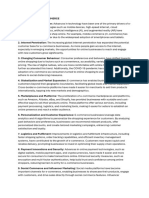66
66
Uploaded by
Poornima ManoharanCopyright:
Available Formats
66
66
Uploaded by
Poornima ManoharanCopyright
Available Formats
Share this document
Did you find this document useful?
Is this content inappropriate?
Copyright:
Available Formats
66
66
Uploaded by
Poornima ManoharanCopyright:
Available Formats
**Case Study: Nike's Digital Transformation Journey**
**Background:**
Nike, a global leader in sports apparel and footwear, began its digital
transformation journey in the mid-2010s in response to shifting consumer
behaviors, driven by the growth of e-commerce, digital channels, and a demand
for personalized experiences. To remain competitive and increase direct
engagement with customers, Nike embraced digital technologies to streamline
operations, enhance customer experience, and drive growth.
**Key Challenges:**
1. **Declining Retail Foot Traffic**: With the rise of e-commerce, Nike faced
decreasing sales from traditional brick-and-mortar retail stores.
2. **Need for Personalization**: Consumers increasingly demanded personalized
shopping experiences and product recommendations.
3. **Operational Inefficiencies**: Managing the supply chain, forecasting demand,
and responding to trends in real-time became more challenging as Nike expanded
globally.
**Digital Transformation Initiatives:**
1. **Direct-to-Consumer (DTC) Strategy**:
Nike shifted its focus from wholesale distribution through third-party retailers to
a more direct relationship with consumers. This included expanding its e-
commerce platform (Nike.com) and mobile apps, such as the Nike App and Nike
Training Club, offering a personalized shopping experience. The goal was to
enhance customer engagement and create a seamless omnichannel experience.
2. **Nike Membership Program**:
Nike introduced a membership model that gave exclusive access to products,
early releases, and personalized content through its digital platforms. This
program allowed Nike to collect customer data, enabling targeted marketing and
personalized offers. The membership helped Nike build a community of loyal
customers, enhancing both online and in-store engagement.
3. **Data-Driven Product Design and Supply Chain**:
Nike integrated data analytics into its design and supply chain processes. By
analyzing customer preferences and sales data, Nike was able to predict demand
more accurately and optimize inventory management. This also allowed them to
produce limited-edition, high-demand products, reducing waste and excess
inventory.
4. **Use of Artificial Intelligence and Machine Learning**:
Nike adopted AI and machine learning to enhance product recommendations on
its digital platforms. By analyzing user behavior, Nike’s algorithms recommended
products tailored to individual preferences, increasing conversion rates and
customer satisfaction.
5. **Digital Innovation in Retail**:
Nike’s flagship stores were redesigned to incorporate digital elements such as
interactive product displays, self-service checkout, and in-store mobile app
integration. Customers could scan QR codes to view product information, request
items from stock, or have their sizes delivered to fitting rooms through the app.
6. **Acquisitions to Boost Digital Capabilities**:
To accelerate its transformation, Nike acquired several tech startups, such as
**Celect** (for predictive analytics in inventory management) and **Invertex**
(for 3D scanning and AI-driven product recommendations). These acquisitions
helped Nike enhance its technological capabilities and provide more innovative
services to customers.
**Results:**
1. **Revenue Growth**: Nike’s digital transformation strategy paid off, with its
digital sales growing by 84% in 2020. By 2021, Nike had projected that digital
channels would account for 50% of its total sales.
2. **Customer Loyalty**: Nike’s membership program significantly boosted
customer loyalty. Members accounted for a large portion of online sales, and
Nike’s personalized approach kept customers engaged.
3. **Improved Operational Efficiency**: By leveraging data analytics and
predictive modeling, Nike streamlined its supply chain and improved demand
forecasting, reducing production lead times and minimizing overstock.
4. **Increased Engagement and Innovation**: The use of digital tools not only
enhanced the shopping experience but also provided Nike with the flexibility to
respond to market changes more quickly. Nike's investments in AI and data-driven
personalization strengthened its position as an innovative leader in the industry.
**Conclusion:**
Nike's successful digital transformation highlights the importance of investing in
technology and building direct relationships with consumers. Through its DTC
strategy, data-driven innovations, and commitment to digital tools, Nike was able
to reinvent itself in a highly competitive market and ensure long-term growth. This
case illustrates how companies can use digital transformation to adapt to
changing consumer behavior, enhance operational efficiency, and stay ahead of
industry trends.
You might also like
- Case Study# Nike Digital StrategyDocument2 pagesCase Study# Nike Digital StrategyASAD ULLAHNo ratings yet
- BSBMKG433 Student Assessment TasksDocument20 pagesBSBMKG433 Student Assessment TasksFrancis Dave Peralta BitongNo ratings yet
- gr534 - Paper - The Evolution of Nikes E-Commerce StrategyDocument14 pagesgr534 - Paper - The Evolution of Nikes E-Commerce Strategyapi-322487708100% (1)
- Standard Costing ICAIDocument60 pagesStandard Costing ICAIRhea Zenu100% (1)
- DALDADocument35 pagesDALDAAkasha Ali 057100% (1)
- EDocument17 pagesEMark Cyphrysse Masiglat67% (3)
- Digital Marketing TrendsDocument9 pagesDigital Marketing TrendsAkif YTNo ratings yet
- Pran JalDocument7 pagesPran Jalkiced78014No ratings yet
- Digital Markeeting ProjectsDocument12 pagesDigital Markeeting ProjectsPrahalad PalNo ratings yet
- Detailed_Digital_Marketing_ExpandedDocument5 pagesDetailed_Digital_Marketing_ExpandeddaghisawNo ratings yet
- E-Business Assignment IIIDocument9 pagesE-Business Assignment IIINguvitjita MutateNo ratings yet
- Strategic ManagementDocument12 pagesStrategic Managementsachanniharika9No ratings yet
- Deloitte MAPIC Report Winning in RetailDocument12 pagesDeloitte MAPIC Report Winning in Retailsyellapr2No ratings yet
- BIKRIDocument16 pagesBIKRIgmdicballliaNo ratings yet
- NikeDocument4 pagesNikeAnshi SharmaNo ratings yet
- The Impact of Digital Marketing On Business Growth in ZimbabweDocument4 pagesThe Impact of Digital Marketing On Business Growth in ZimbabweNgoniNgodzaMangomaNo ratings yet
- Enhanced_Turkish_Digital_Lira_StrategyDocument2 pagesEnhanced_Turkish_Digital_Lira_StrategyAhmetNo ratings yet
- Learning Dairy FinalDocument15 pagesLearning Dairy Finaljugnu gargNo ratings yet
- Explain The Range of Digital Approaches Taken by A Few Real-Life OrganisationsDocument7 pagesExplain The Range of Digital Approaches Taken by A Few Real-Life Organisationsanhyeuly040924No ratings yet
- BPSMDocument6 pagesBPSMankush sharmaNo ratings yet
- AkshayDocument12 pagesAkshayvinayakkausadikar6No ratings yet
- Module 7 - ICT - Project - Management - Theory - Practice - Draft1Document9 pagesModule 7 - ICT - Project - Management - Theory - Practice - Draft1John J. MacasioNo ratings yet
- E BusinessDocument15 pagesE BusinessOmeYadavNo ratings yet
- Internet As Online Sales Channel: Submitted By-Group 4, Sec-2 SLMTDocument19 pagesInternet As Online Sales Channel: Submitted By-Group 4, Sec-2 SLMTIsha SahuNo ratings yet
- Marketing_Strategy_2025Document8 pagesMarketing_Strategy_2025ivoryjamestmiNo ratings yet
- busness proposalDocument6 pagesbusness proposalBhavesh PawarNo ratings yet
- E Commerce 1 UnitDocument3 pagesE Commerce 1 Unitlokeshburagana6No ratings yet
- Digital Marketing EssayDocument2 pagesDigital Marketing EssayrengaboyfiesNo ratings yet
- 3.Digital Marketing NotesDocument23 pages3.Digital Marketing NotesSambit MohapatraNo ratings yet
- shsconf_icdeba2024_01007Document11 pagesshsconf_icdeba2024_01007e_deepaNo ratings yet
- Benefits of Digital MarketingDocument2 pagesBenefits of Digital Marketingafzalrao451No ratings yet
- E Commerce IntroductionDocument42 pagesE Commerce IntroductionMatoke NahasonNo ratings yet
- Internet Marketing - Customer PerspectiveDocument28 pagesInternet Marketing - Customer PerspectivemicliqwebNo ratings yet
- Ecommerce SumarisedDocument8 pagesEcommerce SumarisedNaman BahriNo ratings yet
- Technology and InnovationDocument1 pageTechnology and Innovationkartikeymittal107No ratings yet
- 32063_madalenamoura-2Document56 pages32063_madalenamoura-2iamr200717No ratings yet
- Nike Supply Chain DesignDocument6 pagesNike Supply Chain DesigncelestinenyakwebaNo ratings yet
- Nike Marketing AnalysisDocument33 pagesNike Marketing AnalysisSamia BsgNo ratings yet
- Contekan FullDocument48 pagesContekan Fullwhisnuananda08No ratings yet
- SLMT2 - Internet As Online Sale - Group 4Document15 pagesSLMT2 - Internet As Online Sale - Group 4Isha SahuNo ratings yet
- P1. Understand Marketing Through The Internet P 1.1 Explain The Elements of Internet MarketingDocument6 pagesP1. Understand Marketing Through The Internet P 1.1 Explain The Elements of Internet MarketingpriyaNo ratings yet
- Takaful BazaarDocument15 pagesTakaful BazaarMahnoor baqaiNo ratings yet
- AssignmentDocument7 pagesAssignmentkhusboo870021No ratings yet
- Enterp Assign 2Document2 pagesEnterp Assign 2hammadalamgir778No ratings yet
- Module 3 EComDocument23 pagesModule 3 EComsibadiluNo ratings yet
- Emerging Technology Impact On Future of Business - VikramDocument12 pagesEmerging Technology Impact On Future of Business - Vikramvickybhardwaj1309No ratings yet
- Tacn Topic 1Document5 pagesTacn Topic 1Phương NhưNo ratings yet
- Does IT Pay Off HSBC and CitiDocument6 pagesDoes IT Pay Off HSBC and CitiIIMnotes100% (1)
- AasthaDocument7 pagesAasthakhusboo870021No ratings yet
- Digital EcommerceDocument19 pagesDigital EcommerceReza NurrobbiNo ratings yet
- Digital TransformationDocument77 pagesDigital TransformationRASHNo ratings yet
- Nike IntroductionDocument7 pagesNike Introductiondhanush RNo ratings yet
- 16 IDT - Vietnam Q4 2023 - Assignment 1 - Ly NguyenDocument10 pages16 IDT - Vietnam Q4 2023 - Assignment 1 - Ly Nguyenchi.nguyen22003771No ratings yet
- Relationship MarketingDocument59 pagesRelationship MarketingMirah AndiNo ratings yet
- Tutorial 1Document7 pagesTutorial 1jimmysurana10No ratings yet
- Nike OmniDocument4 pagesNike OmniARSHIA MEHRANo ratings yet
- Pandemic digital marketing game changersDocument6 pagesPandemic digital marketing game changerskarthik83.v209No ratings yet
- Opportunities and ChallengesDocument3 pagesOpportunities and Challengesindradhanushgroup9No ratings yet
- preview-9781000770537_A43369531Document37 pagespreview-9781000770537_A43369531Aumi NadimNo ratings yet
- Digtial MarketingDocument6 pagesDigtial Marketingnikitabuva17No ratings yet
- How AI is Redefining Marketing Strategies for BrandsDocument4 pagesHow AI is Redefining Marketing Strategies for Brandsimran.rahmanNo ratings yet
- EshopDocument8 pagesEshopAlphonce Kiprono0% (1)
- RTM End TermDocument30 pagesRTM End TermAnchal AryanNo ratings yet
- Notice To The MarketDocument1 pageNotice To The MarketJBS RINo ratings yet
- KYC Norms Full ProjectDocument72 pagesKYC Norms Full ProjectGaurav Golecha100% (1)
- Debt Invetment: Summary: InvestmentDocument3 pagesDebt Invetment: Summary: InvestmentEphine PutriNo ratings yet
- PowerPoint Chapter 7 - Strategic Compensation 9eDocument42 pagesPowerPoint Chapter 7 - Strategic Compensation 9esamiha jahanNo ratings yet
- Seed Funding CompaniesDocument4 pagesSeed Funding Companieskirandasi123No ratings yet
- Importance of Packaging in Supply ChainDocument6 pagesImportance of Packaging in Supply ChainLauraNo ratings yet
- Fe&Ia MCQ Questions-1Document50 pagesFe&Ia MCQ Questions-1220333No ratings yet
- This Study Resource WasDocument3 pagesThis Study Resource WasKyree VladeNo ratings yet
- CH 10 CsolDocument47 pagesCH 10 Csolxuzhu5No ratings yet
- Lesson 2 Organization PDFDocument20 pagesLesson 2 Organization PDFAngelita Dela cruzNo ratings yet
- Hmda Truck Dock Logistics Private Limited - Company, - QuickCompanyDocument7 pagesHmda Truck Dock Logistics Private Limited - Company, - QuickCompanygvcNo ratings yet
- AE6 - Chapter 1 - Cash and Cash EquivalentsDocument9 pagesAE6 - Chapter 1 - Cash and Cash Equivalentsrosendasaranza46No ratings yet
- Ecommerce Market Place For Laundry Service: Multi Vendor & Multi CityDocument2 pagesEcommerce Market Place For Laundry Service: Multi Vendor & Multi CitySanjiv VermaNo ratings yet
- Entrep PPT 3Document9 pagesEntrep PPT 3Tina Mae Warez100% (1)
- RTU Paper Solution: Global Institute of Technology, JaipurDocument45 pagesRTU Paper Solution: Global Institute of Technology, JaipurSuresh SinghNo ratings yet
- KAS Dan PIUTANG (Bab 7)Document58 pagesKAS Dan PIUTANG (Bab 7)Nana Febriana AsaliNo ratings yet
- Administrative Coordinator CV Example 1Document3 pagesAdministrative Coordinator CV Example 1bettyirmasari18No ratings yet
- Comparative Analysis A Project ReportDocument58 pagesComparative Analysis A Project ReportSunny AroraNo ratings yet
- Pom A1.1Document27 pagesPom A1.1ye yeNo ratings yet
- Fundamentals of Accounting: The Institute of Cost Accountants of IndiaDocument1 pageFundamentals of Accounting: The Institute of Cost Accountants of Indiapranjal kalitaNo ratings yet
- Capital Expenditures BudgetDocument4 pagesCapital Expenditures BudgetDawit AmahaNo ratings yet
- Yours SincerelyDocument2 pagesYours SincerelyronNo ratings yet
- Preferences of Consumer For LongganisaDocument10 pagesPreferences of Consumer For LongganisaFretchNo ratings yet
- Ajol File Journals - 531 - Articles - 119125 - Submission - Proof - 119125 6253 328874 1 10 20150709Document3 pagesAjol File Journals - 531 - Articles - 119125 - Submission - Proof - 119125 6253 328874 1 10 20150709Thabang MasekwamengNo ratings yet
- How To Promote Your e Commerce Business in The Uae Official GuideDocument6 pagesHow To Promote Your e Commerce Business in The Uae Official GuideAlvan ZaputraNo ratings yet
- Gamble 8e Ch03 PPT ACCESSDocument48 pagesGamble 8e Ch03 PPT ACCESSkimwellmartinNo ratings yet

























































































